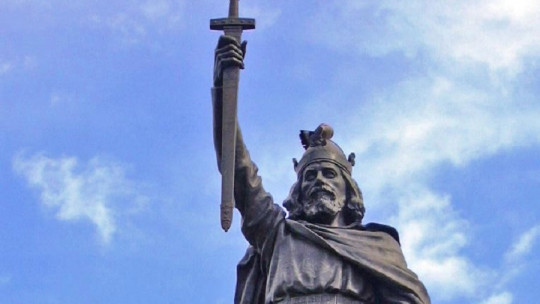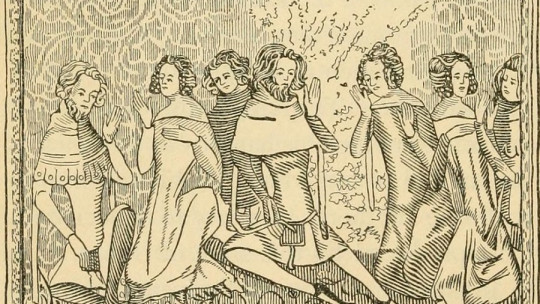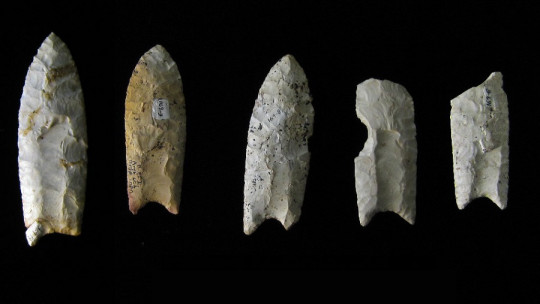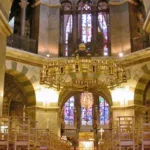Considered to be very ancient ancestors of the Germans and the English, The Saxons were a Germanic tribe that inhabited Europe between the 2nd and 11th centuries AD They are known for having received little influence from Roman culture and even foiling the Empire’s plans in the north of the continent.
The Saxon people expanded through various places in northern Europe, reaching the British Isles where they established some kingdoms that, over time, would form the seed that would give rise to the current English culture.
Next we are going to see in depth what the Saxon people were like how they expanded throughout Europe, what type of society they had and what their religion was like.
What were the Saxon people?
The Saxon people were a group of Germanic tribes that originally lived near the area where the Elbe River flows into Germany As time went by, this town expanded, reaching other territories in continental Europe and the British Isles.
This culture laid the foundations for several modern European countries, including England and Germany especially because they managed to reduce the Latin influence of the Romans from whom they managed to snatch many territories.
The name “Saxon” is believed to come from the word “seax” or “sax”, a type of sword characteristic of this people. Today, this element is part of the symbolism of those who consider themselves descendants of the Saxons, as is the case of the English counties of Essex and Middlesex. The German states of Saxony, Lower Saxony and Saxony-Anhalt are also named after this town.
History of the Saxons
The first mention of the Saxons is from the 2nd century AD. C. and is the work of the Egyptian geographer Claudius Ptolemy They were said to live in the territory of Jutland, located between the North Sea and the Elbe River. Its earliest area of influence was limited to the north by the Jutes, to the northeast by the Angles, to the south by the Franks and to the west by the Frisians, all of them Germanic tribes that shared the same religion, customs and traditions and, in addition, their languages. They were mutually understandable.
As time went by, the Saxons spread. They carried out piracy raids in the North Sea area and in the 3rd and 4th centuries AD. C. they headed south to the region of the Weser River, where they encountered the Caucos and the Angrivarians, two Germanic tribes that they managed to subdue and assimilate. During the second half of the 4th century AD. C. the Saxons invaded territories administered by the Romans and, already at the end of the 6th century AD. C., all of northwest Germany up to the Elbe River was Saxon territory.
It is between the 5th and 6th centuries that an event occurs that will be transcendental for the history of the British Isles. It is at this time that some groups of Saxons invade Britain and, there, they join other peoples who had also reached the islands, such as the Angles and the Jutes. The Roman Empire had managed to reach the British Isles, but the weakness of recent years meant that the province they tried to establish in what is now England and part of Scotland ended up collapsing.
At the beginning of the 7th century, the Anglo-Saxon conquest of Britain ended, with the Saxons settling in the southern part of the Thames and founding the kingdoms of Wessex, Essex and Sussex to the west, east and south respectively. The Angles also founded their kingdoms: East Anglia, Northumbria and Mercia. Another Germanic tribe, in this case the Jutes, did not want to lose the option of having a British kingdom, creating the kingdom of Kent. These seven states would be unified into an Anglo-Saxon monarchy in the 10th century under the reign of Alfred the Great.
The way of speaking of the Saxons is considered the language directly predecessor to English and partly to German. The Anglo-Saxons, that is, the combination of the Saxons with the Angles and, in part, the Jutes, ruled over England until the reign of Edward the Confessor. Its power declined when, in 1066, the Norman conquest of the region occurred. Despite the change in political power, the language of this people remained in the region, evolving into modern English.
Political organization
The Saxons had a fairly simple political organization, at least during the first centuries. They were organized around the figure of the Thane, who acted as head of the tribe made up of about twenty families In turn, the group of one hundred Saxon families made up the “Hundreds” (Hundreds), who lived in the villages and corresponded to a tribe of greater size and complexity.
The Saxon system of political power was monarchical, with a king. The monarch was not hereditary, although he used to be a relative of the previous monarch who was chosen to carry out this position. Those in charge of choosing the new king made up the “Witan” or Council of Wise Men. On the other hand, the judicial power of the Saxons was exercised by the Shire court.
Social organization of the Saxons
The Saxon social structure was made up of three classes: the edhilingi, the frilingi and the lazzi As aristocrats, the Edhilingi had privileges above others, enjoying the trust of the king to assert his authority in the Hundreds. On the other hand, the frilingui or free men had a harder life, dedicating themselves to working the land and taking care of the livestock, working to support their families and pay tributes to kings and nobles. Finally, lazzi were usually prisoners of war made slaves or people bought from other tribes for forced labor.
Economy
As with other Germanic peoples and, also, as in most tribal-type cultures, The main economic activity of the Saxons was agriculture and cattle and sheep farming They worked on the land of the latifundia, farming areas belonging to the nobles in which they extracted the taxes that went to the king, in addition to keeping a proportion to support their families. They also traded with neighboring towns, exchanging both crafts and slaves.
Saxon religion
The early Saxons were polytheists, a trait shared with many other Germanic peoples. They worshiped different gods from Norse mythology, in addition to believing in the forces of nature. These tribes worshiped the changes of season, celebrating the equinoxes and solstices, an element that was also shared with the Celts who gave great importance to the cycles of nature.
The Saxons They had a religious institution, the Ealdormen, literally “the old men.” who, due to their advanced age, were considered very wise and had been granted a high rank within the Shire. In addition to being in charge of the rituals and worship of the gods of the Norse pantheon, they controlled and administered the Saxon lands, having enough authority to raze any region that posed an obstacle.
We cannot talk about the religion of the Saxons without mentioning some of their gods , whose names have remained for posterity in the form of sculptures, engravings and inscriptions on all types of monuments and remains in Germany, England and other Germanic countries. Furthermore, the Norse gods are the ones who give names to the days of the week in practically all Germanic languages, including German and English, such as Odin for Wednesday (Wednesday), Thor for Thursday (Thursday) and Freya for Friday ( Friday).
1. Odin
Odin He was the most powerful god in the pantheon, father of all other gods He ruled in the house of the Norse gods, Asgard, and his weapon was the “gungnir”, a type of very powerful spear that he only used in battle. On the fighting field he was not separated from his extremely fast steed, Sleipnir, which had eight legs.
2.Thor
thor He was considered one of the strongest gods in the Norse pantheon , descendant of Odin and guardian of the power of thunder. He also had an aptitude for war and was characterized by fighting with his hammer, which always returned to his hand no matter where he had ended up.
3. Freya
freya She is one of the best known and most revered goddesses by both the Saxons and other Germanic peoples She was considered the goddess of fertility, love and beauty and her function resembled that of the goddess Aphrodite. In the Saxon worldview she was credited with creating the magical arts and spells that made up Norse “seidr” magic. This goddess perfected and taught these powers to other gods.









